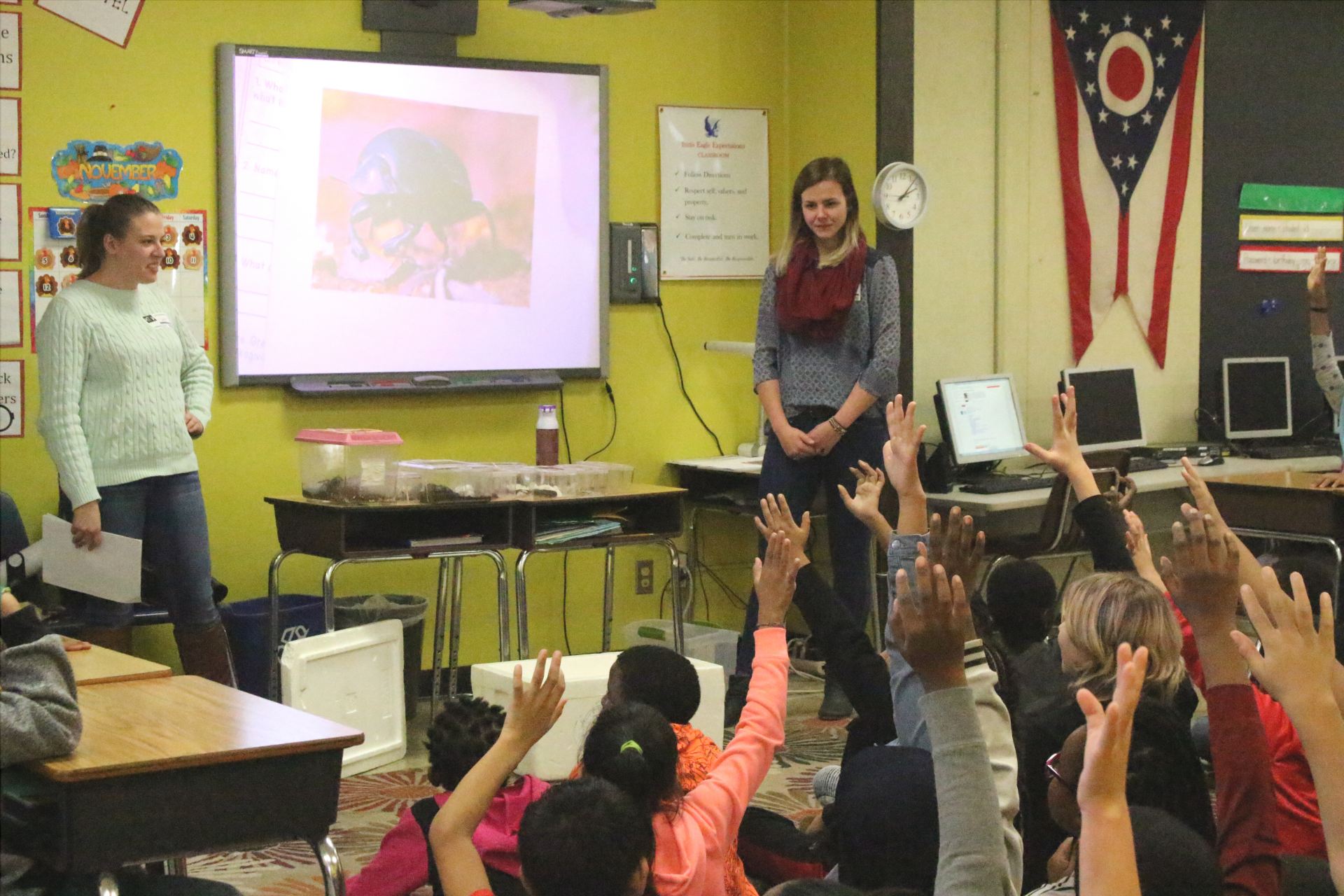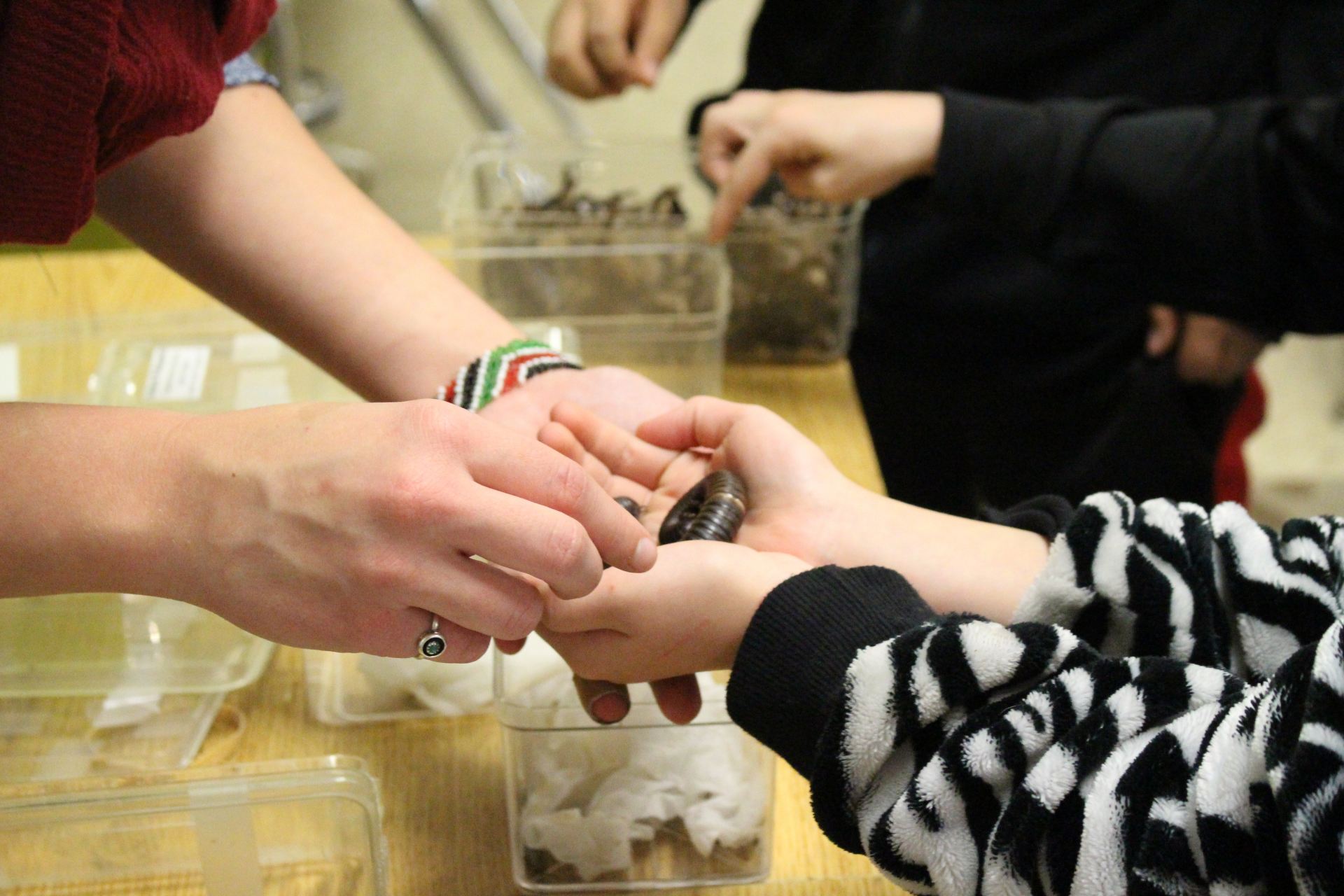
Ohio State students Taylor Brown, left, a fourth-year in evolution and ecology, and Sophie Aller, a fourth-year in zoology, present a variety of arthropods to Leisa Rogers’s and Staci McCafferty’s third grade classes at Innis Elementary in Northeast Columbus. The presentation was one of several outreach events put on each year by UResearch. Credit: Matt Dorsey | Engagement Editor
Two Ohio State students stand in front of an elementary school classroom and hold the attention of — and even command enthusiasm from — 45 third-graders. The two are not accomplishing this feat by themselves, however. They are getting a huge assist from a big styrofoam cooler full of bugs.
Taylor Brown, a fourth-year in evolution and ecology, and Sophie Aller, a fourth-year in zoology, are teaching assistants for Zeynep Benderlioglu’s UResearch undergraduate research courses, where community outreach — such as Tuesday’s arthropod presentation to the third-graders at Innis Elementary School in Northeast Columbus — is a significant portion of what the courses are all about.
The program is run by the Department of Evolution, Ecology and Organismal Biology, and features two courses in a series — the first offered each Spring Semester, the second each Autumn — to give students hands-on experience in developing the skills necessary to conduct research projects.

Sophie Aller, a fourth-year in zoology, places a millipede in an Innis Elementary third-grader’s hands at Tuesday’s UResearch outreach event. Credit: Matt Dorsey | Engagement Editor
Benderlioglu began the program as an independent-study offering in 2011 so students from any area of study could learn the ins and outs of field research before applying those skills in their graduate studies.
She created the two courses, Entering Independent Research and Undergraduate Research in Behavioral Ecology, after more students were signing up for the independent study than she could handle.
The outreach mission has been important to her from the beginning.
“While [students are] training, there is one goal for me,” Benderlioglu said. “I’m saying that ‘OK, you’re getting all these resources, you’re learning how to become scientists, you’re learning how to do research, and this is a service provided by the university, by my department, and now you have to give back to the community. Whatever you learn, we have to reach out, especially to younger kids.’”
Students can learn so much by knowing how much [insects] contribute to the development of the earth. — Zeynep Benderlioglu, lecturer who runs UResearch courses
The mission of cultivating scientific curiosity in children is personal for Benderlioglu because she grew up in Turkey, a place she said lacked funding for adequate science education at the time. Then, after coming to the U.S. in 1995, she enrolled as a graduate student at Ohio State and became a parent, a development she said had a major influence on the program she created.
“I had a child and I wanted him to have the opportunities that I didn’t have. And I wanted to teach youngsters, because I was fascinated by everything that I was learning at a very old age,” she said. “And I wanted my son to be aware— not to grow up like me, unaware of the biodiversity, the science and nature all around him.”
Benderlioglu and her teaching assistants collectively demonstrate at multiple outreach events each year, typically at elementary schools. Tuesday’s event was the third of the 2017-18 academic year and was enthusiastically received by the thrilled and surprisingly well-behaved third-grade students, and also by their teachers.

Sophie Aller, a fourth-year in zoology, presents tarantula exoskeletons to Innis Elementary School third-graders as part of Tuesday’s UResearch outreach event. Credit: Matt Dorsey | Engagement Editor
Leisa Rogers, one of two Innis teachers whose classes combined for the presentation, said not many outside organizations come to the school to present, but that it was more than welcome.
“This is great,” she said. “The students get hands-on experience.”
And hands-on it was. Brown and Aller pulled multiple containers from their cooler, each containing a different type of arthropod, and carried many of them — including a mealworm, a hissing cockroach, a millipede and a Northern walking stick — around the room for students to touch while explaining key characteristics of each one. The third-graders engaged eagerly and none of them visibly recoiled in fear or disgust.
“Who wants to study animals when they’re older?” Brown asked near the end of the presentation. Nearly every hand in the class went up.
The arthropod presentation is one of three the UResearch team presents to various groups of children. Another centers on how dung beetles use light from the Milky Way to navigate, and a third involves getting students to solve the mystery of why termites will follow any line drawn with a pen. (Spoiler: termites are blind, but they react to a chemical in the ink.)
The emphasis on insects is intentional, Benderlioglu said, because they are diverse and engage in fascinating behaviors, but can be thought of as a scary presence later in life if the critters are not introduced early to children.
“Students can learn so much by knowing how much [insects] contribute to the development of the earth,” she said.
Brown, who coordinates the outreach events as well as lab activities for the UResearch classes, is, like Benderlioglu, a true believer in the outreach mission of the program.
“It’s one thing if you can advance your field and advance knowledge in your field and create breakthroughs, but educating the public and increasing STEM participation and increasing scientific literacy is the other component that’s incredibly important for STEM fields,” Brown said. “So for me, being able to participate in these outreach events, is, one, incredibly rewarding, and two, incredibly needed in the community.”
The Engaged Scholars logo accompanies stories that feature and examine research and teaching partnerships formed between The Ohio State University and the community (local, state, national and global) for the mutually beneficial exchange of knowledge and resources. These stories spring from a partnership with OSU’s Office of Outreach and Engagement. The Lantern retains sole editorial control over the selection, writing and editing of these stories.



